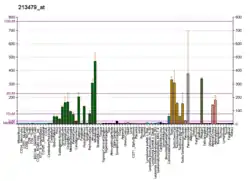| NPTX2 | |||||||||||||||||||||||||||||||||||||||||||||||||||
|---|---|---|---|---|---|---|---|---|---|---|---|---|---|---|---|---|---|---|---|---|---|---|---|---|---|---|---|---|---|---|---|---|---|---|---|---|---|---|---|---|---|---|---|---|---|---|---|---|---|---|---|
| Identifiers | |||||||||||||||||||||||||||||||||||||||||||||||||||
| Aliases | NPTX2, NARP, NP-II, NP2, neuronal pentraxin 2 | ||||||||||||||||||||||||||||||||||||||||||||||||||
| External IDs | OMIM: 600750 MGI: 1858209 HomoloGene: 1892 GeneCards: NPTX2 | ||||||||||||||||||||||||||||||||||||||||||||||||||
| |||||||||||||||||||||||||||||||||||||||||||||||||||
| |||||||||||||||||||||||||||||||||||||||||||||||||||
| |||||||||||||||||||||||||||||||||||||||||||||||||||
| |||||||||||||||||||||||||||||||||||||||||||||||||||
| |||||||||||||||||||||||||||||||||||||||||||||||||||
| Wikidata | |||||||||||||||||||||||||||||||||||||||||||||||||||
| |||||||||||||||||||||||||||||||||||||||||||||||||||
Neuronal pentraxin-2 is a protein that in humans is encoded by the NPTX2 gene.[5][6]
Function
This gene encodes a member of the family of neuronal pentraxins, synaptic proteins that are related to C-reactive protein. This protein is involved in excitatory synapse formation. It also plays a role in clustering of alpha-amino-3-hydroxy-5-methyl-4-isoxazolepropionic acid (AMPA)-type glutamate receptors at established synapses, resulting in non-apoptotic cell death of dopaminergic nerve cells.[6]
Clinical significance
Up-regulation of this gene in Parkinson disease (PD) tissues suggests that the protein may be involved in the pathology of PD
References
- 1 2 3 GRCh38: Ensembl release 89: ENSG00000106236 - Ensembl, May 2017
- 1 2 3 GRCm38: Ensembl release 89: ENSMUSG00000059991 - Ensembl, May 2017
- ↑ "Human PubMed Reference:". National Center for Biotechnology Information, U.S. National Library of Medicine.
- ↑ "Mouse PubMed Reference:". National Center for Biotechnology Information, U.S. National Library of Medicine.
- ↑ Hsu YC, Perin MS (Feb 1996). "Human neuronal pentraxin II (NPTX2): conservation, genomic structure, and chromosomal localization". Genomics. 28 (2): 220–7. doi:10.1006/geno.1995.1134. PMID 8530029.
- 1 2 "Entrez Gene: NPTX2 neuronal pentraxin II".
Further reading
- Park JK, Ryu JK, Lee KH, et al. (2007). "Quantitative analysis of NPTX2 hypermethylation is a promising molecular diagnostic marker for pancreatic cancer". Pancreas. 35 (3): e9–15. doi:10.1097/MPA.0b013e318153fa42. PMID 17895837. S2CID 31006962.
- Marui T, Koishi S, Funatogawa I, et al. (2007). "No association between the neuronal pentraxin II gene polymorphism and autism". Prog. Neuropsychopharmacol. Biol. Psychiatry. 31 (4): 940–3. doi:10.1016/j.pnpbp.2007.02.016. PMID 17408830. S2CID 23877321.
- Poulsen TT, Pedersen N, Perin MS, et al. (2006). "Specific sensitivity of small cell lung cancer cell lines to the snake venom toxin taipoxin". Lung Cancer. 50 (3): 329–37. doi:10.1016/j.lungcan.2005.06.011. PMID 16115696.
- Gerhard DS, Wagner L, Feingold EA, et al. (2004). "The Status, Quality, and Expansion of the NIH Full-Length cDNA Project: The Mammalian Gene Collection (MGC)". Genome Res. 14 (10B): 2121–7. doi:10.1101/gr.2596504. PMC 528928. PMID 15489334.
- Hillier LW, Fulton RS, Fulton LA, et al. (2003). "The DNA sequence of human chromosome 7". Nature. 424 (6945): 157–64. Bibcode:2003Natur.424..157H. doi:10.1038/nature01782. PMID 12853948.
- Scherer SW, Cheung J, MacDonald JR, et al. (2003). "Human Chromosome 7: DNA Sequence and Biology". Science. 300 (5620): 767–72. Bibcode:2003Sci...300..767S. doi:10.1126/science.1083423. PMC 2882961. PMID 12690205.
- Strausberg RL, Feingold EA, Grouse LH, et al. (2003). "Generation and initial analysis of more than 15,000 full-length human and mouse cDNA sequences". Proc. Natl. Acad. Sci. U.S.A. 99 (26): 16899–903. Bibcode:2002PNAS...9916899M. doi:10.1073/pnas.242603899. PMC 139241. PMID 12477932.
- Kirkpatrick LL, Matzuk MM, Dodds DC, Perin MS (2000). "Biochemical interactions of the neuronal pentraxins. Neuronal pentraxin (NP) receptor binds to taipoxin and taipoxin-associated calcium-binding protein 49 via NP1 and NP2". J. Biol. Chem. 275 (23): 17786–92. doi:10.1074/jbc.M002254200. PMID 10748068.
- Dodds DC, Omeis IA, Cushman SJ, et al. (1997). "Neuronal pentraxin receptor, a novel putative integral membrane pentraxin that interacts with neuronal pentraxin 1 and 2 and taipoxin-associated calcium-binding protein 49". J. Biol. Chem. 272 (34): 21488–94. doi:10.1074/jbc.272.34.21488. PMID 9261167.
This article incorporates text from the United States National Library of Medicine, which is in the public domain.
This article is issued from Wikipedia. The text is licensed under Creative Commons - Attribution - Sharealike. Additional terms may apply for the media files.




